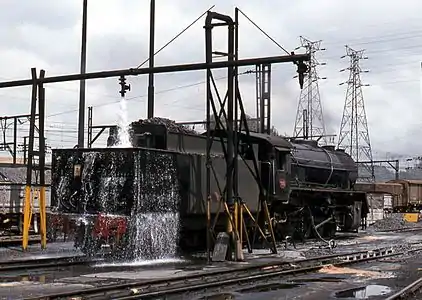South African type JT1 tender
The South African type JT1 tender was a steam locomotive tender.
 Type JT1 tender on Class S1, 19 March 1983 | |||||||||||||||||||||||||||||||||
| |||||||||||||||||||||||||||||||||
| |||||||||||||||||||||||||||||||||
| |||||||||||||||||||||||||||||||||
Type JT1 tenders first entered service in 1947, as tenders to the Class S1 0-8-0 eight-coupled shunting locomotives which were built and placed in service by the South African Railways in that year. In 1953 and 1954, 25 more entered service, built in Scotland.[1][2][3][4][5]
Manufacturers
Type JT1 tenders were built between 1947 and 1953 by the South African Railways (SAR) and North British Locomotive Company (NBL).[1][2]
In 1947 and 1948, the SAR built and placed twelve Class S1 eight-coupled shunting steam locomotives in service. The engines and tenders were built by the Salt River shops in Cape Town to the design of Dr. M.M. Loubser, Chief Mechanical Engineer (CME) of the SAR from 1939 to 1949, and were initially placed in service in the yards in Cape Town. A further 25 Class S1 locomotives were subsequently ordered from NBL in Glasgow, built in 1953 and delivered in 1953 and 1954. The Type JT1 entered service as tenders to these locomotives.[1][2][3]
Characteristics
The tender was arranged for manual stoking and had a coal capacity of 11 long tons (11.2 tonnes) and a water capacity of 6,000 imperial gallons (27,300 litres). As on the Type GT tender of the Class S shunting locomotive, the top sides of its coal bunker were set inwards to improve the crew's rearward vision. The front of the engine and the back of the tender were fitted with modified and strengthened draft gear and both were fitted with vacuum brakes. It was built with an underframe and bogies identical to those of the Type JT tender.[1][2][3][4][5]
Locomotive
Only the Class S1 locomotives were delivered new with Type JT1 tenders, which were numbered in the ranges from 374 to 385 and 3801 to 3825 for their engines. An oval number plate, bearing the engine number and tender type, was attached to the rear end of the tender.[1][4][5]
Classification letters
Since many tender types are interchangeable between different locomotive classes and types, a tender classification system was adopted by the SAR. The first letter of the tender type indicates the classes of engines to which it can be coupled. The "J_" tenders could be used with the locomotive classes as shown.[4][5]
The second letter indicates the tender's water capacity. The "_T" tenders had a capacity of between 5,587 and 6,000 imperial gallons (25,400 and 27,300 litres; 6,710 and 7,210 US gallons).[5]
A number, when added after the letter code, indicates differences between similar tender types, such as function, wheelbase or coal bunker capacity.[5]
.jpg.webp) Type JT1 tender on Class S1, 26 June 1963
Type JT1 tender on Class S1, 26 June 1963
References
- Holland, D. F. (1972). Steam Locomotives of the South African Railways. 2: 1910-1955 (1st ed.). Newton Abbott, Devon: David & Charles. pp. 103–104. ISBN 978-0-7153-5427-8.
- Espitalier, T.J.; Day, W.A.J. (1947). The Locomotive in South Africa - A Brief History of Railway Development. Chapter VII - South African Railways (Continued). South African Railways and Harbours Magazine, May 1947. pp. 402-404.
- Paxton, Leith; Bourne, David (1985). Locomotives of the South African Railways (1st ed.). Cape Town: Struik. pp. 80–81. ISBN 0869772112.
- South African Railways & Harbours/Suid Afrikaanse Spoorweë en Hawens (15 Aug 1941). Locomotive Diagram Book/Lokomotiefdiagramboek, 3'6" Gauge/Spoorwydte. SAR/SAS Mechanical Department/Werktuigkundige Dept. Drawing Office/Tekenkantoor, Pretoria. pp. VIII, 47.
- South African Railways & Harbours/Suid Afrikaanse Spoorweë en Hawens (15 Aug 1941). Locomotive Diagram Book/Lokomotiefdiagramboek, 2'0" & 3'6" Gauge/Spoorwydte, Steam Locomotives/Stoomlokomotiewe. SAR/SAS Mechanical Department/Werktuigkundige Dept. Drawing Office/Tekenkantoor, Pretoria. pp. VIII, 6a-7a, 37, 47.